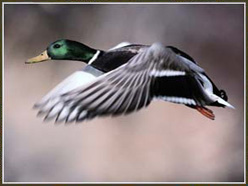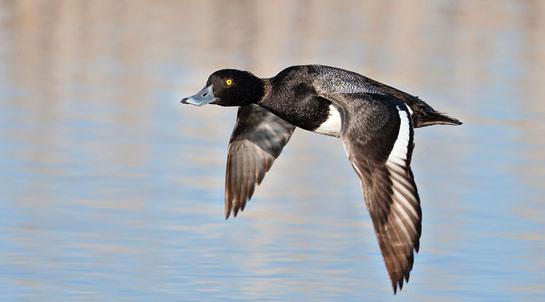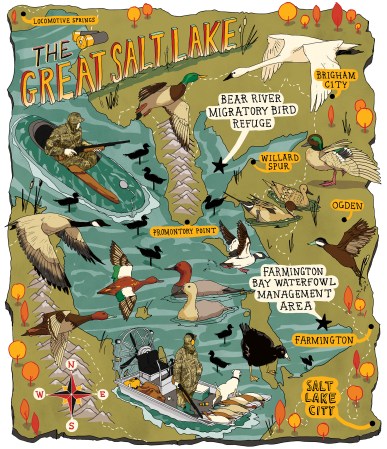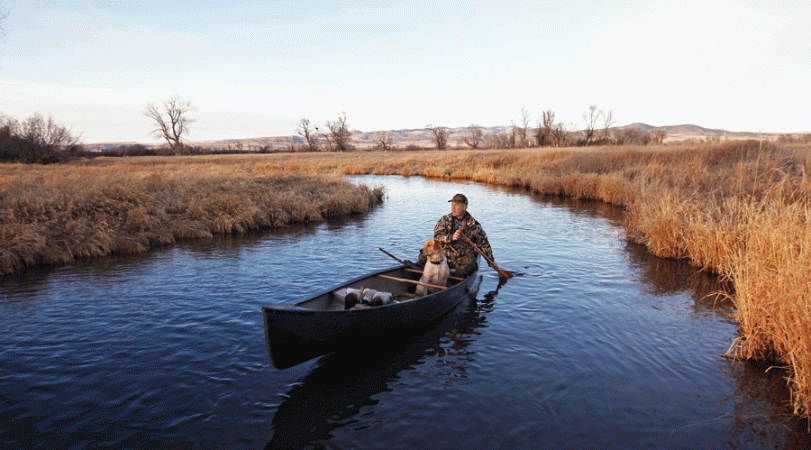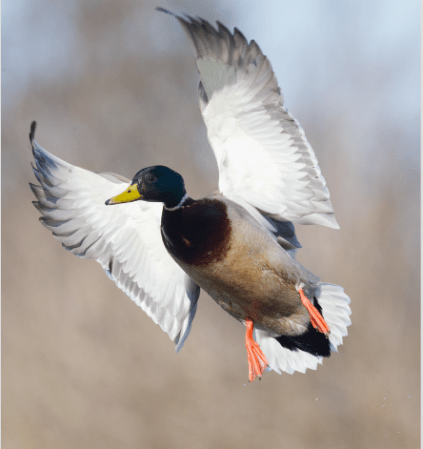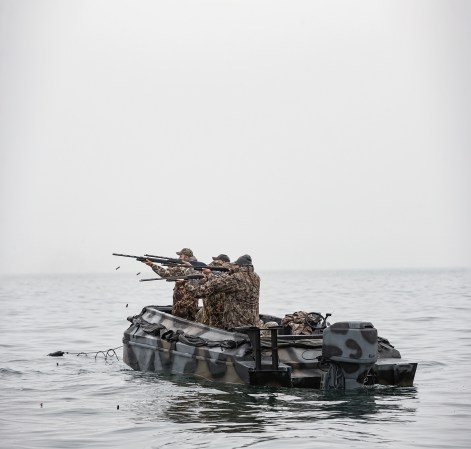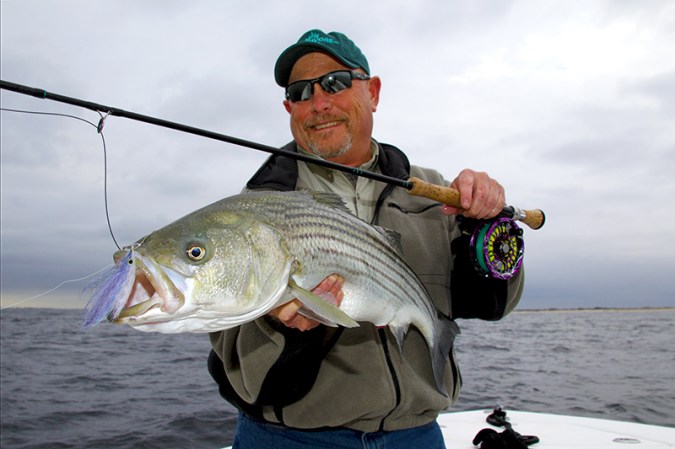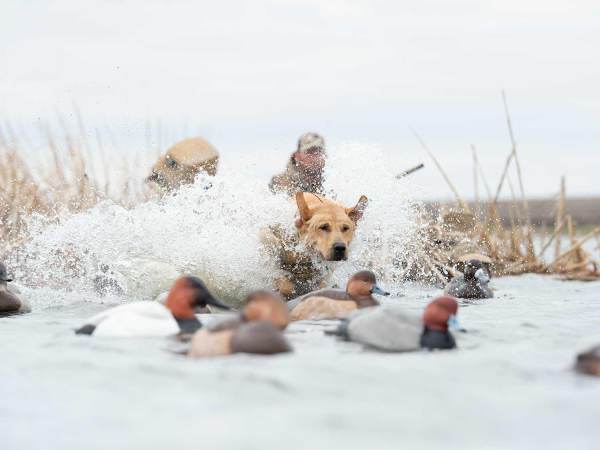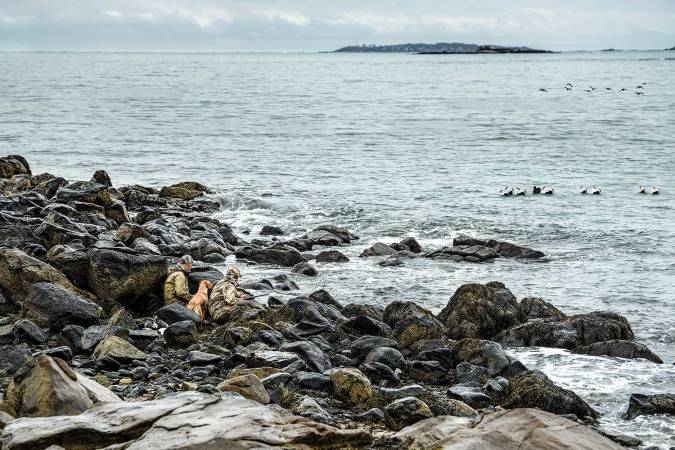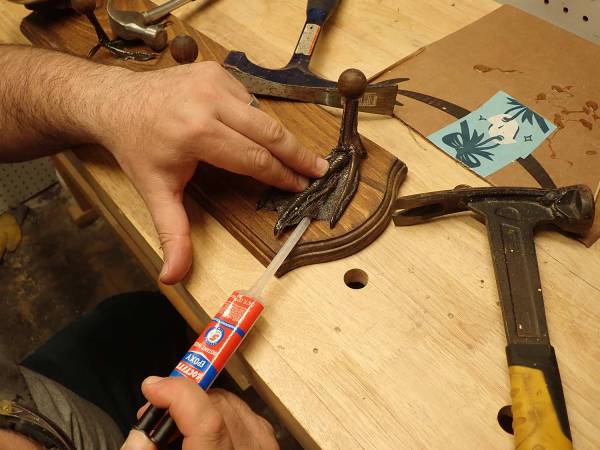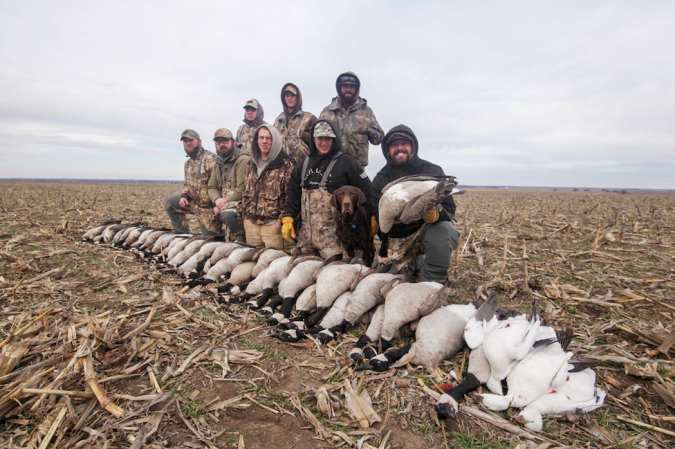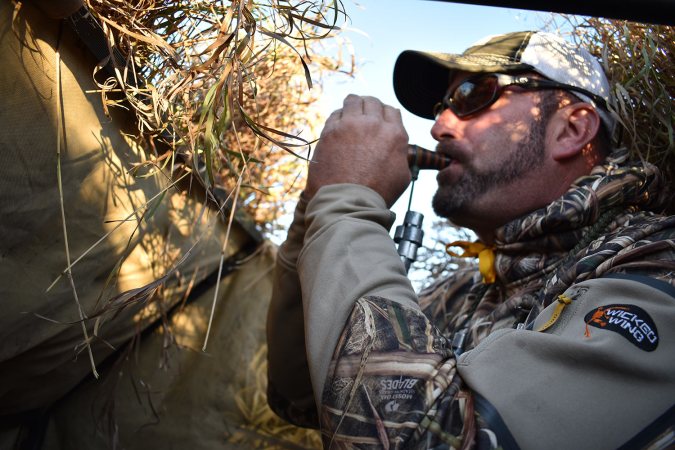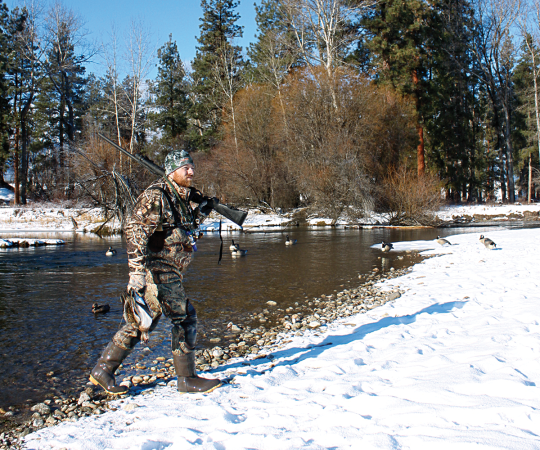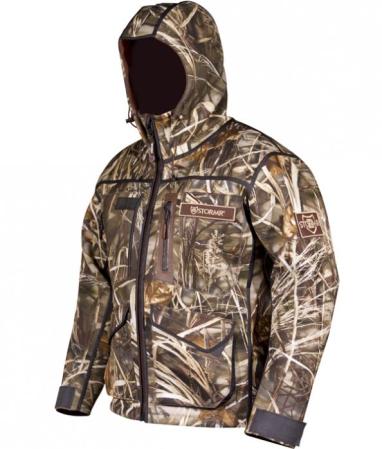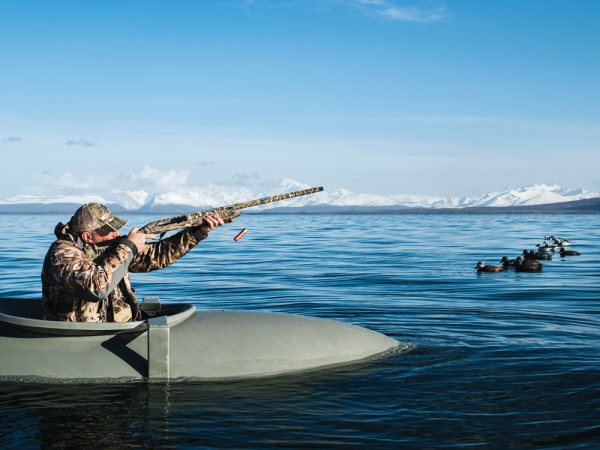Ask any experienced wing-shooter from the Great Lakes and he’ll tell you there are two kinds of duck hunting: ordinary duck hunting and layout shooting.
Ordinary duck hunting is in itself pretty extraordinary. It is an amalgamation of sights and sounds that not only overwhelms the senses, but makes for a downright enjoyable pastime. Layout shooting shares many of these thrills but is more extreme.
Layout shooting is a game played on a different court, sometimes a mile or more from land, where the usual hostile conditions of duck hunting, like wind and precipitation, are multiplied. Layout shooters regularly operate in water deeper than many duck hunters ever even cross, hunting from barely emerged boats that look like a cross between a canoe and a coffin.
Layout boats, available in one- and two-man models, are generally painted a flat, winter-water gray so they disappear into the environment. The profile of the boat rests just inches above the waterline. The hunters lay out in the bottom of the rig, which is anchored just upwind of a hundred or more decoys, sitting up to shoot as the birds barrel by. It can be fast, frustrating and fantastic-often all in the course of the same hunt.
“All duck hunting’s pretty good, but one nice thing is when you’re out on the open water, you can see things develop at a distance,” says Jerry Martz, a long-time layout shooter who spent 20-plus years as the waterfowl specialist at the Michigan Department of Natural Resources. “And when you’ve got seventy-five birds coming in at top speed, it blows your mind. The shooting is sometimes difficult-that business of sitting up and shooting can be frustrating. It’s tough for a right- hander to shoot to the right, for instance.
“But once you’ve got some experience with it and if the birds are doing everything right, you can shoot doubles, and good shots pull off triples.”
If your duck-hunting experience is limited to dabblers, your first exposure to laying out will be eye-opening. These birds generally don’t lock up on high, circle and fall in gracefully. Divers come zipping in, often low over the water like a fighter pilot approaching an aircraft carrier. If they do decide to fall in, they simply stick out their wings and hit the air brakes, crashing in with all the finesse of a fullback hitting the line on fourth and inches.
Often as not, though, they’ll just keep on going at speeds that’ll make you wonder how you ever missed a mallard or teal, especially one dropping into the decoys.
Setting Decoy Rigs
Layout hunting takes advantage of the diving ducks’ habit of rafting up in huge numbers-by the hundreds and sometimes by the thousands-in open water. Competing with those live decoys is nearly impossible. Big sets of decoys-a hundred should be considered a starter set and two hundred is not uncommon-are de rigueur. Some hunters scatter them haphazardly, but most rig decoys on mother lines and string them out in lines downwind of the boat.
A standard setup includes a dozen strings with 10 decoys each, set from either side of the boat. The strings should be a boat-width apart, with an opening in the middle where ducks can land. Using two boats and sets of several hundred decoys helps to compete with the big rafts of divers.
Layout shooting is an equipment- intensive game. It takes a minimum of two boats-one to tow or carry the layout, set decoys and pick up fallen ducks, and another to shoot from. Many outfitters have three, using a large craft as a mother ship and a smaller outboard as a tender.
If you use just two, the tender must be sizable. Not only must it carry the hunting party and enough decoys to fill a sporting-goods store, but it must be seaworthy. Weather changes can develop quickly on the big water.
Even when everything’s working, layout shooting can be a challenge. The best hunting, of cose, generally occurs on the days that duck hunters hope for: overcast with a strong north wind, maybe with a little rain or snow and a good chop on the water to keep the blocks moving. The shooting is from the seat of your pants, rocking in sometimes heavy seas.
Diving ducks, so named because they dive to feed rather than tip up (or dabble), are often low on the list of preferred sporting species, trailing well behind mallards and pintails. But redheads and canvasbacks are true trophy ducks. Even the less popular species-goldeneyes, buffleheads, bluebills-that are collectively known as “black-and-whites,” range from handsome to gorgeous, with iridescent purple and green feathers highlighting their drab heads. Layout shooting is a terrific option for collectors who want to add unusual species, like oldsquaw, scoters and eiders, to their displays. They taste good, too. Given a bad rap by some wild-game aficionados because they consume mollusks, divers typically feed on wild celery and other aquatic vegetation. Redheads and canvasbacks were the prime targets of market hunters because they are quite pleasing to the palate.
A Team Sport
Layout shooting is a team sport; you cannot do it alone. Four guys with a two-man rig make a perfect combination. Pairs alternate between time in the layout and a turn operating the chase boat. Generally, the chase boat anchors more than a quarter-mile away. It’s especially helpful to work in pairs when you have to chase crippled birds. They can be hard to spot, tough to pin down-often diving when approached only to resurface at a great distance-and difficult to kill while on the water.
Although it is most closely associated with big water-the Great Lakes region and the Eastern seaboard-there is a debate about where the layout technique developed. Certainly it has been with us a long time; layout shooting was employed by market hunters who tried to take out whole flocks at once. The technique, though, is suitable to any expanse of open water. Martz, for instance, occasionally trailers his rig to Louisiana for some exceptional shooting on Lake Pontchartrain. The wide-open lower ends of many reservoirs are perfect for divers and typically offer little competition, since most hunters are targeting puddle ducks in the marshes.
As with any hunting endeavor, scouting can be the key to exceptional sport. You have to be where the ducks want to be, and that can change in hours. Just setting up in the middle of a wide expanse of water isn’t going to work. Missing a flight path by a hundred yards or so can be as bad as being off by a mile. Layout shooting is unique in the waterfowling world. Beginners are befuddled by how often they sit up when the birds are still out of range, or how quickly the ducks are gone if they’re tardy getting into shooting position.
Layout Boats
Layout shooting used to be the exclusive sport of those with the skill to build rigs in their garages and barns. Over time, regional cottage industries developed and more waterfowlers soon found serviceable layout boats.
Manufacturers now offer everything from classic pumpkinseed-shaped rigs to more traditionally styled duck boats reworked for layout shooting. A good layout boat combines buoyancy and stability while maintaining the lowest of profiles. Layouts should have rounded edges that melt into the lake’s surface and should not cast shadows. There also should be enough boat behind the hunter for it to ride the waves without water crashing over into the cockpit.
Ron Bankes Marine of Port Rowan, Ontario, has been making layout boats since 1968. The small, one-man Pumpkinseed is 10 feet long with a 4-foot beam, weighs 90 pounds and retails for $995 USD. The one-man Hercules-for bigger hunters and bigger water-measures 14 feet long and 53 inches wide, weighs 200 pounds and sells for $1,795. The 400-pound two-man Revolution resembles two 14-foot one-man boats joined at the hip. With a 7-foot beam, it features separate cockpits for each shooter and costs $2,995. For more information visit www.bankesboats.com.
The Mighty Layout Boys started making fiberglass layouts three years ago and the boats have received rave reviews. Their 10-foot-long, 50-inch-wide one-man boat weighs 80 pounds and sells for $1,100. The two-man MLB II is a 13-foot 3-inch pumpkinseed-shaped rig with a 73-inch beam; it weighs 210 pounds and retails for $2,495. For more information check www.mightylayoutboys.com.
Lock, Stock and Barrell of Clinton Township, Mich., makes a classic two-man boat, the Whistler. The 131/2- footer has an 80-inch beam, weighs 230 pounds and retails for $3,195, though a kit is available for $2,195. Owner Lou Tisch also makes a couple of hybrids that he uses for layout and marsh hunts. The South Bay Scooter resembles a sneak boat and can handle a 7.5-horsepower outboard; it retails for $2,795. For more information visit www.lockstockbarrell.com.
If you yearn for an old-fashioned, handmade wooden boat, John Kalash of Moscow, Mich., makes rigs that are considered the Cadillacs of layout boats in the Detroit River and Lake Erie areas. Kalash, who’s been building boats for more than 50 years, still turns out five or six of his 12-foot-long, 5-foot-wide, 100-pound boats a year. Available in one- and two-man models, Kalash boats retail for $900 and $1,100 respectively. For information call 517-849-5022.lution resembles two 14-foot one-man boats joined at the hip. With a 7-foot beam, it features separate cockpits for each shooter and costs $2,995. For more information visit www.bankesboats.com.
The Mighty Layout Boys started making fiberglass layouts three years ago and the boats have received rave reviews. Their 10-foot-long, 50-inch-wide one-man boat weighs 80 pounds and sells for $1,100. The two-man MLB II is a 13-foot 3-inch pumpkinseed-shaped rig with a 73-inch beam; it weighs 210 pounds and retails for $2,495. For more information check www.mightylayoutboys.com.
Lock, Stock and Barrell of Clinton Township, Mich., makes a classic two-man boat, the Whistler. The 131/2- footer has an 80-inch beam, weighs 230 pounds and retails for $3,195, though a kit is available for $2,195. Owner Lou Tisch also makes a couple of hybrids that he uses for layout and marsh hunts. The South Bay Scooter resembles a sneak boat and can handle a 7.5-horsepower outboard; it retails for $2,795. For more information visit www.lockstockbarrell.com.
If you yearn for an old-fashioned, handmade wooden boat, John Kalash of Moscow, Mich., makes rigs that are considered the Cadillacs of layout boats in the Detroit River and Lake Erie areas. Kalash, who’s been building boats for more than 50 years, still turns out five or six of his 12-foot-long, 5-foot-wide, 100-pound boats a year. Available in one- and two-man models, Kalash boats retail for $900 and $1,100 respectively. For information call 517-849-5022.
